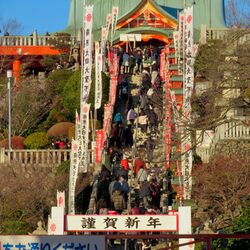Religion:Hatsumōde
}}
Hatsumōde (初詣 hatsumōde) is the first Buddhist temple or Shinto shrine visit of the Japanese New Year.[1] Many visit on the first, second, or third day of the year as most are off work on those days. Generally, wishes for the new year are made, new omamori (charms or amulets) are bought, and the old ones are returned to the shrine so they can be cremated. There are often long lines at major shrines throughout Japan.
Most of the people in Japan outside of the retail and emergency services professions are off work from December 29 until January 3 of every year. It is during this time that the house is cleaned, debts are paid, friends and family are visited and gifts are exchanged. It would be customary to spend the early morning of New Year's Day in domestic worship, followed by consumption of sake (toso) and special celebration food (e.g. osechi, zōni). The act of worship is generally quite brief and individual and may involve queuing at popular shrines.
Some shrines and temples have millions of visitors over the three days. Sensoji temple in Tokyo is the most popular one. Meiji Shrine for example had 3.45 million visitors in 1998, and in the first three days of January 2010, 3.2 million people visited Meiji Jingū, 2.98 million Narita-san, 2.96 million Kawasaki Daishi, 2.7 million Fushimi Inari-taisha, and 2.6 million Sumiyoshi Taisha.[2][3] Other popular destinations include Atsuta Jingū, Tsurugaoka Hachimangū, Dazaifu Tenman-gū, and Hikawa Shrine.[4]
A common custom during hatsumōde is to buy a written oracle called omikuji. If the omikuji predicts bad luck purchasers can tie it onto a tree on the shrine grounds, in the hope that its prediction will not come true. The omikuji goes into detail, and offers predictions in various areas of life, such as business and love, for that year, in a similar way to horoscopes in the West. Often a good-luck charm comes with the omikuji when purchased.[citation needed]
Shrines make much of their money in the first week or two of the year.
Ninenmairi
Ninenmairi (二年参り) is a style of Hatsumode. It is called a "two year visit" not because it takes place over two years but rather the event starts on New Year's Eve and ends on New Year's Day, thus happening over two years.[5][6] People will frequently write wishes for the year on Ema for the year[7]
Toshikoshi-soba is eaten an hour before midnight[8]
See also
- Saisakimode
- Ōmisoka
- Glossary of Shinto
- Christmas and holiday season
- Maison Ikkoku
References
- ↑ "初詣はいつまでにいけばいい? 正しい作法と開運のポイント" (in Japanese). TV Tokyo Corporation. 1 January 2020. https://www.tv-tokyo.co.jp/plus/lifestyle/entry/2020/020952.html. "本来は氏神様や菩提寺に新年のご挨拶にいくこと (Translation: Originally it is to give New Year's greetings to one's ancestral shrine or temple)"
- ↑ "Japan's Society Celebrations - Hatsumōde". http://www.asianinfo.org/asianinfo/japan/society_celebrations.htm.
- ↑ "'Tis the season for shrines and temples to rake it in". The Japan Times. 3 January 2011. http://blog.japantimes.co.jp/yen-for-living/tag/hatsumode/.
- ↑ "Encyclopedia of Shinto - Hatsumōde". Kokugakuin University. 24 February 2007. http://eos.kokugakuin.ac.jp/modules/xwords/entry.php?entryID=1069.
- ↑ "Meaning of 二年参り, にねんまいり, ninenmairi | Japanese Dictionary | JLearn.net" (in en). https://jlearn.net/dictionary/%E4%BA%8C%E5%B9%B4%E5%8F%82%E3%82%8A.
- ↑ "December | MustLoveJapan Video Travel Guide". https://www.mustlovejapan.com/month/dec/.
- ↑ "English | 弥彦観光協会公式サイト/やひ恋". https://www.e-yahiko.com/en/.
- ↑ "The Runner | A beginner's guide to December holidays and events other than Christmas" (in en-US). 2021-12-17. https://runnermag.ca/2021/12/a-beginners-guide-to-december-holidays-and-events-other-than-christmas/.
 |


